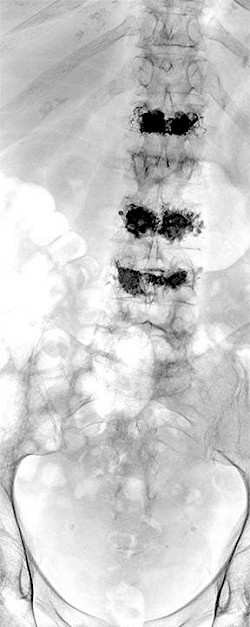Osteoporosis: New surgery through the keyhole

Minimally invasive treatment in patients with osteoporosis-related vertebral fractures
With the help of so-called kyphoplasty, fractured or porous vertebrae can be stabilized again in patients with advanced osteoporosis. The minimally invasive surgical technique effectively relieves pain and improves the patients' quality of life. The spine centre of the KLINIK am RING achieves excellent results with this innovative treatment method.
Osteoporosis mainly occurs in post-menopausal women when hormonal changes deplete calcium stores in the bones. In men, too, the bone can lose strength and break even at low loads. In advanced osteoporosis, the risk of a vertebra breaking is quite common. Movement such as turning around in bed can lead to a so-called compression fracture of the spine. Although these fractures are only an exceptional threat to the spinal cord running in the spinal canal, they can cause very severe back pain. "These pains are often misinterpreted as wear and tear-related, thus preventing effective treatment," explains Dr Timmo Koy, Head of the Spine Centre at the Clinic am RING in Cologne.
Stabilization and straightening of the vertebral body
In patients with osteoporosis-related vertebral fractures, adequate pain therapy and, if necessary, stabilization with a corset are always at the forefront of therapy. "However, if this does not bring the desired success and the pain persists, kyphoplasty is an effective and minimally invasive surgical procedure," emphasizes the spinal specialist. With this so-called keyhole operation, hollow needles are inserted into the fractured vertebra via two small skin incisions, which are no longer than five millimetres. Through these two balloons are introduced, which are pumped up in the vertebral body. The porous bone is "compressed" at the sides and the vertebra can be straightened up again and its old height can be recovered. Then the balloons are removed again. The cavity is finally filled with viscous bone cement, which hardens quickly at body temperature in the vertebra and supports it from the inside.
Immediate pain relief
"The results are excellent," explains Dr. Koy. Most patients report an immediate relief of their pain and a significant improvement in their quality of life after surgery. Once the fracture has been stabilized, however, the real problem must not be lost sight of - osteoporosis itself. It must be treated by drug substitution of calcium and vitamin D. It is also often necessary to use drugs that inhibit bone resorption. This reduces the probability of suffering another fracture. "In order to assess the success of the therapy, bone density measurement is also indispensable," sums up the spine specialist.
For further information:

